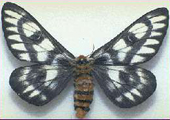Native Plants
Search for native plants by scientific name, common name or family. If you are not sure what you are looking for, try the Combination Search or our Recommended Species lists.
Artemisia tridentata
Artemisia tridentata Nutt.
Big Sagebrush, Great Basin Sagebrush
Asteraceae (Aster Family)
Synonym(s):
USDA Symbol: ARTR2
USDA Native Status: L48 (N), CAN (N)
Big sagebrush or Great Basin sagebrush is an evergreen shrub, 1-1/2 - 9 ft. tall, with a gnarled spread somewhat less than its height. It may have a short trunk or be branched from the base. Small, velvety, silvery leaves have a sweet, pungent aroma and, en masse, give a bluish-gray effect.
Big Sagebrush is the dominant shrub over vast areas of the Great Basin region. Several subspecies have been identified, all more or less similar to the typical form. Sagebrush is a valuable forage plant for wildlife, particularly during the winter. It is browsed by deer, moose, elk, antelope, and bighorn sheep, especially in late winter and spring. Sage grouse also feed heavily on sagebrush, which also provides nesting sites for a variety of songbirds. Even more nutritious than alfalfa, this shrub consists of 16 percent proteins, 15 percent fats, and 47 percent carbohydrates. Humans have used the plant primarily as firewood—the volatile oils responsible for its pungent aroma are so flammable that they can cause even green plants to burn.
Plant Characteristics
Duration: PerennialHabit: Shrub
Root Type: Tap
Leaf Retention: Evergreen
Leaf Complexity: Simple
Size Notes: Up to about 9 feet tall.
Leaf: Blue-gray
Fruit: Fruit is a cypsela (pl. cypselae). Though technically incorrect, the fruit is often referred to as an achene.
Bloom Information
Bloom Color: YellowBloom Time: Jun , Jul , Aug , Sep , Oct , Nov
Distribution
USA: AZ , CA , CO , ID , MA , MT , ND , NE , NM , NV , OR , SD , UT , WA , WYCanada: AB , BC
Native Distribution: W. Great Plains, w. to B.C. & Baja CA. Massachusetts' inclusion on list is based on voucher specimen collected in Middlesex County. The species is very likely not native there.
Native Habitat: Open, dry plains; hills; slopes
Growing Conditions
Water Use: MediumLight Requirement: Sun
Soil Moisture: Dry
CaCO3 Tolerance: High
Soil Description: Dry, rocky soils.
Conditions Comments: Periodic pruning to remove old stems rejuvenates Artemisia tridentata. Plants are extremely drought tolerant and are susceptible to root rot if too wet. Nitrogen-fixing. Intolerant of alkalinity. Commercial seed of this species may belong to one of three common subspecies: Basin - tridentata, Mountain - vaseyana & Wyoming - wyomingensis. These subspecies are adapted to distinct environments, so it is important to identify seed sources. Pollen is a cause of hayfever.
Benefit
Use Wildlife: An important wildlife plant.Use Medicinal: Tea drunk for relief of nasal congestion. Many Zuni believe boiling the plant over the stove will prevent colds. (Steiner)
Use Other: Places in shoes or mocassins as a foot deodorant. Indigenous Californians used young shoots for fire drills.
Fragrant Flowers: yes
Fragrant Foliage: yes
Value to Beneficial Insects
Provides Nesting Materials/Structure for Native BeesThis information was provided by the Pollinator Program at The Xerces Society for Invertebrate Conservation.
Butterflies and Moths of North America (BAMONA)
|
Hera buckmoth (Hemileuca hera)  Larval Host |
Propagation
Description: Half-ripened wood under mist give some rooting success. Seeds should germinate easily.Commercially Avail: yes
Find Seed or Plants
Find seed sources for this species at the Native Seed Network.
View propagation protocol from Native Plants Network.
From the National Organizations Directory
According to the species list provided by Affiliate Organizations, this plant is on display at the following locations:Santa Barbara Botanic Garden - Santa Barbara, CA
Native Seed Network - Corvallis, OR
Bibliography
Bibref 1186 - Field Guide to Moths of Eastern North America (2005) Covell, C.V., Jr.Bibref 1185 - Field Guide to Western Butterflies (Peterson Field Guides) (1999) Opler, P.A. and A.B. Wright
Bibref 1211 - Folk Medicine: The Art and the Science (1985) Richard P. Steiner
Bibref 946 - Gardening with Prairie Plants: How to Create Beautiful Native Landscapes (2002) Wasowski, Sally
Bibref 1218 - Tending the Wild: Native American Knowledge and the Management of California's Natural Resources (2006) Anderson, M. Kat
Search More Titles in Bibliography
Web Reference
Webref 38 - Flora of North America (2019) Missouri Botanical Garden, St. Louis, MO & Harvard University Herbaria, Cambridge, MA.Additional resources
USDA: Find Artemisia tridentata in USDA PlantsFNA: Find Artemisia tridentata in the Flora of North America (if available)
Google: Search Google for Artemisia tridentata
Metadata
Record Modified: 2022-10-12Research By: TWC Staff